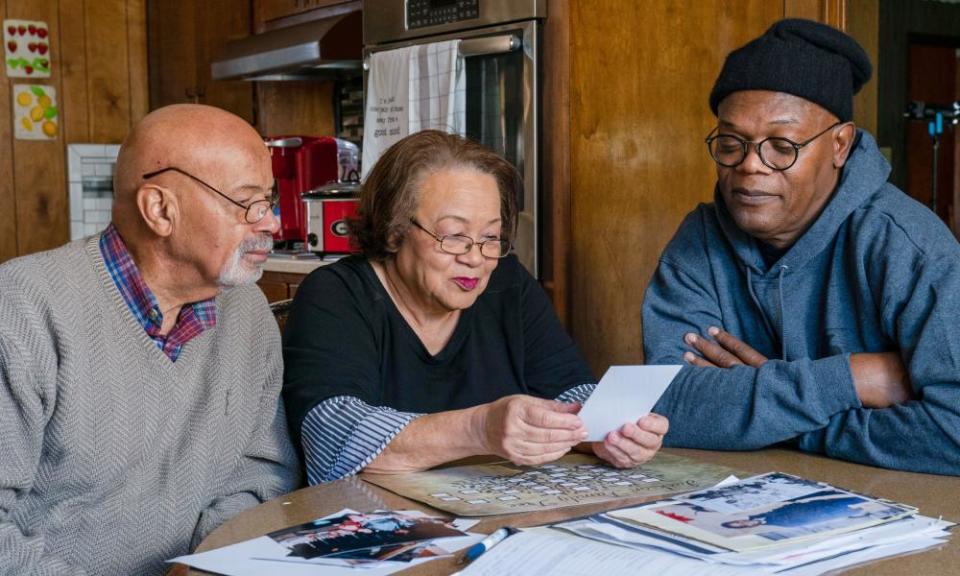Enslaved review – Samuel L Jackson presents a brutally poignant history of the slave trade

This year has seen a proliferation of freshly commissioned shows examining racism in response to the Black Lives Matter movement. Enslaved (BBC Two, Sunday), however, predates the death of George Floyd, and would surely have been prominently screened regardless of this year’s events. After all, it has a bona-fide superstar presenter in Samuel L Jackson, alongside Afua Hirsch of the Guardian and investigative journalist Simcha Jacobovici.
Clearly aware that there have already been numerous slavery documentaries, this four-part series seeks to tell a different story by uncovering new evidence. Full of wide, breathtaking aerial shots of the rivers and coastline of west and central Africa, where the slave trade flourished, it tracks the slave ships’ journeys from Africa to Brazil, the US, the Caribbean or, says Jackson, “the bottom of the ocean”. Up to 1,000 slave ships are thought to have ended up as wrecks. Using new diving technology to locate and examine some of these sunken ships, the series aims to offer a fresh perspective.
It begins with Jackson tracing his family tree back to his great-grandfather, the last in his family to be born a slave. A DNA test suggests his lineage goes back to Gabon, on the Atlantic coast of central Africa. He travels to the region and discovers that there remains a grim record of the brutal trade. African captives, as they waited to board the ships on the shores of the Iguela lagoon, were given nothing but oysters to eat. To this day, there remain huge piles of these shells, discarded by the men and women processed at this spot. Up to four metres high and covering a mind-boggling 2,500 acres, these oyster islands are a stark reminder of hundreds of thousands of lives destroyed, in a trade that shipped 12 million Africans across the Atlantic. “Today, it’s a tropical paradise, but 200 years ago it was a hell on Earth,” Gabon’s environment minister, Lee White, tells Jackson.
Jackson discovers that ivory was also taken from Africa, with elephant tusks loaded alongside the human cargo to boost profits even further: a reminder that, at its heart, slavery – although underpinned by white supremacist beliefs – was driven by extreme, unchecked capitalism, rather than racism alone. Indeed, although the standard way to transport Africans was to cram them in as tightly as possible, in some slave ships they were allowed more space, and even allowed to exercise occasionally. Not out of humanity, of course: the healthier the human cargo looked on disembarkation, the higher the price it would fetch. Emaciated bodies did not sell well.
Jackson and Hirsch travel to Elmina Castle in Ghana, the first trading post on the west African coastline, built by the Portuguese in the 15th century. Thirty more followed. The pair enter one bleak, bare stone chamber in this huge, white-walled construction and, looking out of a narrow passage to the sea, realise it is the “door of no return”. The opening would have led straight on to the ships bound for the Americas. Once Africans passed this point: “It was the end of life as they knew it.” In the middle of the fort’s courtyard, Hirsch spots a church. Somehow, she notes, the traders thought this holy site was compatible with the brutal trade that went on around it.
This part of the show is interesting and informative, and the star power of Jackson would, you would hope, be enough to bring in a new audience to this subject. But, where it might leave viewers a little confused is in the extensive coverage it gives to the diving mission. Yes, the shipwreck evidence does add a fascinating new element. And the divers who search for it (from the Divers with Purpose group) are certainly brave and do great work. But the extended clips of their exploits that intersperse the documentary look not only at their aims, but at their detailed conversations, their machinery, their technical decision-making. Interesting up to a point – like the “How we made it” section at the end of David Attenborough’s Planet Earth documentaries. But instead of being the dessert once you have enjoyed the main meal, it runs in parallel, constantly interrupting the flow – as if a malfunctioning TV remote keeps switching you to a Jacques Cousteau documentary.
Given the heart-rending human tragedies told by Jackson and Hirsch, it feels indulgent to spend so much time on what is, ultimately, the retrieval of an ancient elephant tusk from the seabed, connected though it is to the slave ships.
Perhaps it is all about expectation. The title, Enslaved, will attract those who wish to know more about the trade and its inhumanities, without the extended diving dramas.
Last word to Hirsch, though. She is told of the science that went into the positioning of the triangular sails of tall ships – a 15th-century innovation that harnessed the wind’s power, enabled the ships to sail the oceans at speed, and helped turn the looting of Africa into a business. Hirsch observes: “You think of pioneering technology as a positive thing, but it’s just heartbreaking that Europeans saw this as an opportunity to really embark on their most evil project.”

 Yahoo News
Yahoo News 